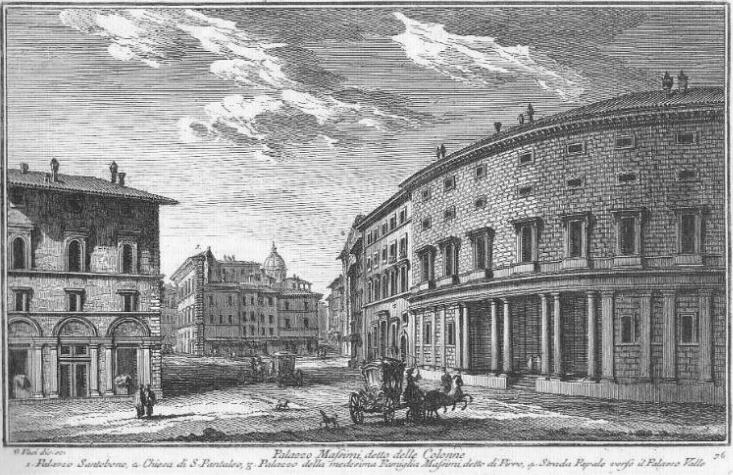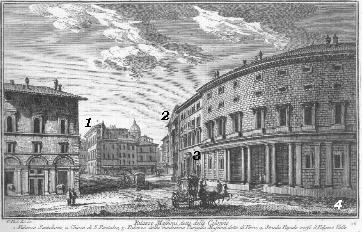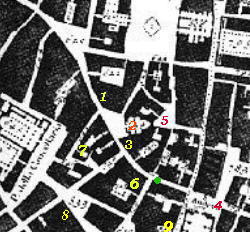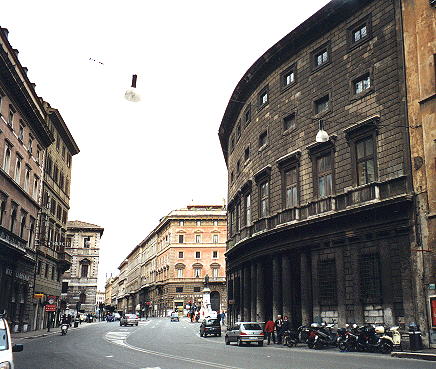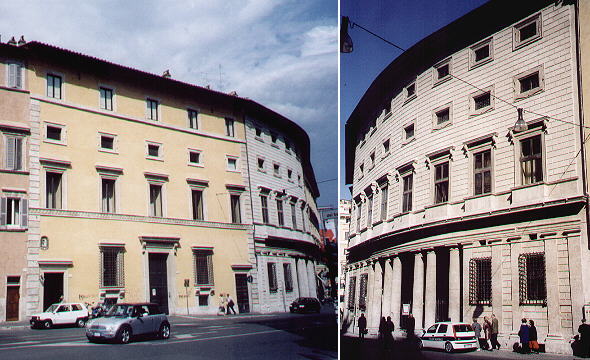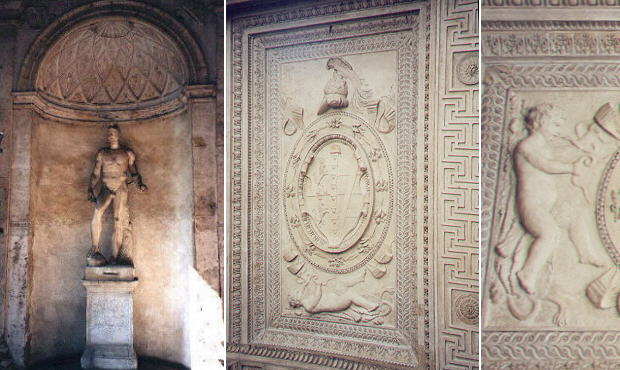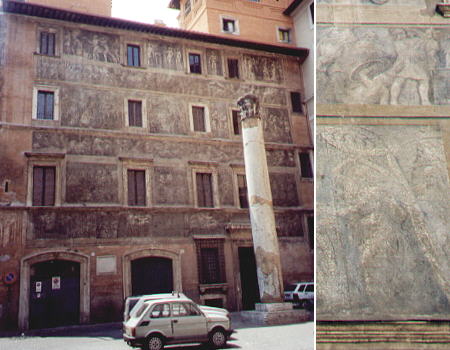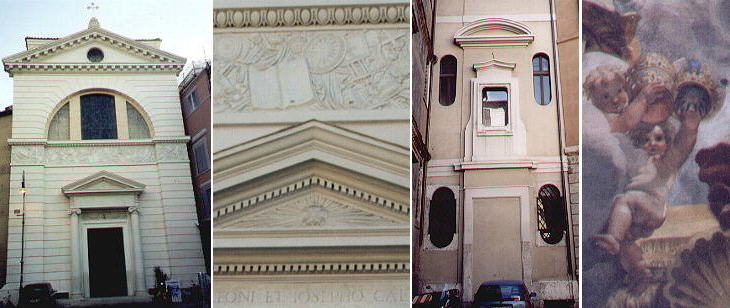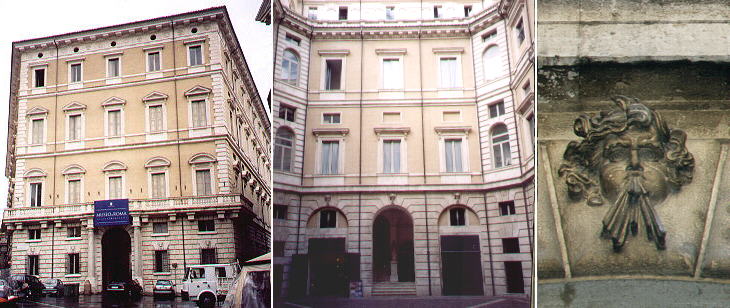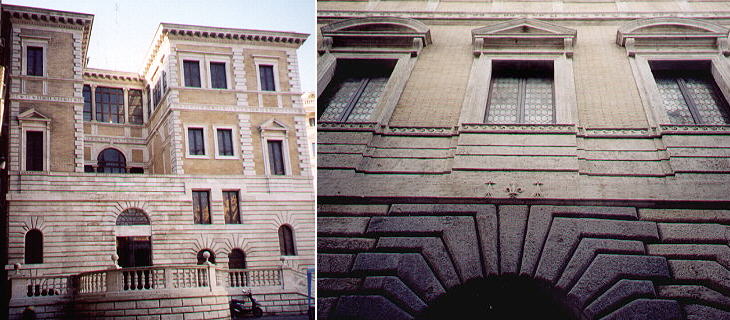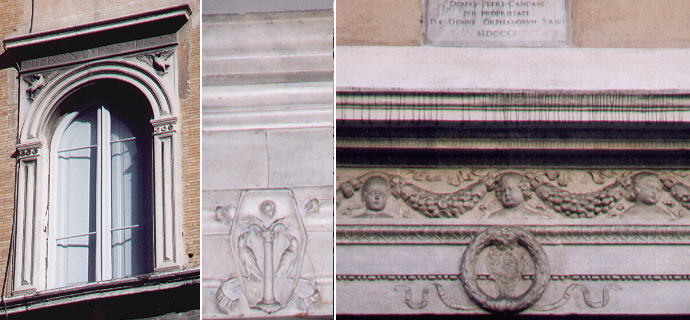  Palazzo Massimi detto delle Colonne (Book 4) (Day 4) (View C7) (Rione Parione) In this page:
On the papal street leading towards St Peter's there were little squares
like this one in front of Palazzo Massimi belonging to a family claiming
to derive from Fabius Maximus Cunctator. The fašade is curved to follow
the line of the street, which was influenced by the existence in this site of an odeon, a
Roman theatre built immediately next to the Stadium of Diocletianus (today Piazza Navona). The view is taken from the green dot in the small 1748 map here below.
In the description below the plate Vasi made reference to: 1) Palazzo Santobono;
2) S. Pantaleo; 3) Palazzo di Pirro (part of Palazzo Massimi); 4) Papal Street leading to Palazzo Valle.
The small map shows also 5) Rear fašade of Palazzo Massimi; 6) Palazzo di Gerolamo Pichi; 7) Farnesina ai Baullari; 8) Palazzo di Ceccolo Pichi; 9) S. Elisabetta dei Fornari.
The need to open a large street between Piazza Venezia and St Peter's led to linking several existing squares like that of Palazzo Massimi. Most of the papal street is immediately north of what is today called Corso Vittorio (Emanuele II). Palazzo Santobono and Chiesa di S. Pantaleo are not visible in the image, nor were they visible in the XVIIIth century, but Vasi nevertheless showed them in his view.
The palace was built by Baldassarre Peruzzi in 1536 on the ruins of a previous palace
destroyed during the Sack of Rome in 1527 and it has some
very innovative solutions, which in some aspects look to the classical
world (for example the portico and the entrance to the inner court) and
in other details (for example the little aerial windows, which you see
in my background) anticipate the future Baroque predilection for curved
lines. The interior was decorated by Poussin and on the second floor the palace has its own private chapel.
The interest of the Massimo family for Roman art is confirmed by a mosaic floor from the Emperor Hadrian's villa.
Every year on March 16 the palace is open to the public in memory of a miracle by S. Filippo Neri, who
brought back to life for a short time a young member of the family. The fašade of the palace was cleaned in 2002.
The rear fašade of Palazzo Massimi shows a typical Renaissance use of graffiti. It was painted in 1523 maybe by Daniele da Volterra and it shows scenes from the Bible. The column, most likely a column of the odeon was re-erected in this site in 1950.
The fašade of the small church of S. Pantaleo was rebuilt by Giuseppe Valadier in 1805 at the expense of the Torlonia family (the new rich of XIXth century Rome). The decoration is similar to that of Piazza del Popolo (another work by Valadier). The back and the interior of the church have maintained their late XVIIth century design (by Giovanni Antonio De Rossi).
In 1790-92 Luigi Braschi Onesti, nephew of the pope in charge (Pius VI), bought and modified the existing Palazzo Santobono to transform it into a stately palace, the last of a long series of palaces built by nephews of the pope who made money during his pontificate (nepotism). The courtyard is decorated with the heraldic symbol of Pius VI. The street to the right of Palazzo Braschi leads to Piazza Navona, while the street to the left leads to Piazza di Pasquino, where you can see another image of Palazzo Braschi and the heraldic symbol of the Onesti family.
Farnesina ai Baullari means (small) Farnese palace in the Baullari (trunk makers) street, but the reference to the Farnese is wrong as the building belonged to a Breton prelate, Thomas le Roy, who had added to his heraldic symbols, the fleurs-de-lis, the arms of the French royal family. This led to assuming the palace belonged to the Farnese, whose heraldic symbols were the fleurs-de-lis too. It was built in 1522 and there is still uncertainty about the architects who designed it: for some time it was attributed to Michelangelo, but today it is thought to be a work either by Antonio da Sangallo the Younger or by Baldassare Peruzzi. The palace was impacted by the opening of Corso Vittorio Emanuele and it got a new fašade on that side. The original fašade (image on the right) is in the rear alley. The small but very elegant loggia is original too, while the steps leading to the building are a modern addition required by the new level of the street. Palazzi di Girolamo e di
Ceccolo Pichi
The print by Vasi shows to the left a large palace which was modified by the opening of Corso Vittorio Emanuele:
by walking in a rear alley one can see its remaining original parts. The house of Girolamo Pichi was built towards the
end of the XVth century. Picchio in Italian means woodpecker and this explains why two woodpeckers
decorate the windows
of the house and a portal (now inside the modern part of the building).
Next plate in Book 4: Palazzo Marescotti You have completed Day 4 itinerary! Move to Day 5. Next step in your tour of Rione Parione: Palazzo della Cancelleria
Go
to |
All images © 1999 - 2003 by Roberto Piperno. Write to romapip@quipo.it
